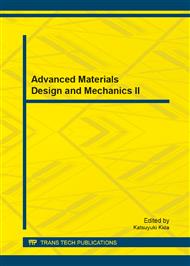[1]
S. Wanger, Amorphous Silicon Solar Cells. 10th E. C PhotovoltaiC Solar Energy Conference (1991), pp.1179-1183.
Google Scholar
[2]
Hochbaum Al, Semiconductor Nanowires for Energy Conversion. Chem Rev 110(1), (2010), pp.527-46.
Google Scholar
[3]
B. K Tian, Single Nanowire Photovoltaics. Chem. Soc. Rev. 38(1), (2009), pp.16-24.
Google Scholar
[4]
Z. Fan Z, R. D. Challanges and Propects of nano-pillar based Solar Cells. Nano Res. 2(11), (2009), pp.829-43.
Google Scholar
[5]
K. Yu, Enhancing Solar Cell Efficiencies Through 1-D Nanostructures. Res. Lett 4(1), (2008), pp.1-10.
Google Scholar
[6]
D. Ginley, Solar Energy Conversion toward 1 Terawatt. MRS Bull, 33, (2008), pp.355-73.
DOI: 10.1557/mrs2008.71
Google Scholar
[7]
M. Law, Semiconductor Nanowires and Nanotubes. Annu. Rev. Matt er. Res. 34(1), (2004), pp.83-122.
Google Scholar
[8]
L. Cao, Resonant Germanium Nano-Antenna Photodetectors. Nano Lett. 10(4), (2010), pp.1229-33.
Google Scholar
[9]
AC Ford, Diameter - Dependant Electron Mobility of InAs Nanowires. Nano Lett 9(1), (2009), pp.360-365.
Google Scholar
[10]
O Gunawan O, Measurement of Carrier Mobilityin Silicon Nanowires. Nano Lett 8(6), (2008), pp.1566-71.
Google Scholar
[11]
J Xiang, Ge/Si Nanowire Heterostructures at High Performance Field - Effect Transistors. Nature, (2006), pp.489-93.
Google Scholar
[12]
Z LWang, Zinc oxide nanostructures: growth, properties and applications. J. Phys.: Condens. Matter, 16, (2004), pp. R829–R858.
DOI: 10.1088/0953-8984/16/25/r01
Google Scholar
[13]
B. J Lokhande, Studies on structural, optical and electrical properties of boron doped zinc oxide films prepared by spray pyrolysis technique. Physica B 302, (2001). pp.59-63.
DOI: 10.1016/s0921-4526(01)00405-7
Google Scholar
[14]
Y. H Cheng Jingquan, Y. H. Preparations and Applications of Ultrofine Zinc Oxide Powders. Journal of Hebei Normal University(Natural Science), 24(4), (2000), pp.509-512.
Google Scholar
[15]
Boule, C. R. (1991). Oxidizing Species Involved in Photocatalytic Transformation on Zinc Oxide[J]. Photochem Photobiol. A: Chem, 60, (1991), p.235.
Google Scholar
[16]
R. K Singh, Ultraviolet-assisted pulsed laser deposition of thin oxide flms. Applied Surface Science 168, (2000), pp.239-243.
DOI: 10.1016/s0169-4332(00)00606-1
Google Scholar
[17]
Z. M Caglar Yasemin, Influence of the indium incorporation on the structural and electrical properties of zinc oxide films. J. Optoelec and Advanc. Mat, 8(5), (2006), pp.1867-1873.
Google Scholar
[18]
S. Shishiyanu, Nanostructured zinc oxide gas sensors by successive ionic layer adsorption and reaction method and rapid photothermal processing. Thin Solid Films 488, (2007).
DOI: 10.1016/j.tsf.2007.10.104
Google Scholar
[19]
P Mitra, ZnO thin film Sensor. Mater. Lett. 35, (1998), pp.33-38.
Google Scholar
[20]
H. A San, Solar Energy, 77, (2004), p.291.
Google Scholar
[21]
D. A Henari, Optical characterization of thermally evaporated thin CdO films. Cryst. Res. Technol. 38, No. 11, (2003), pp.979-985.
DOI: 10.1002/crat.200310124
Google Scholar
[22]
D. M Carballeda-Galicia, High transmittance CdO thin films obtained by the sol-gel method. Electron Lett., 20, (2000), pp.105-108.
DOI: 10.1016/s0040-6090(00)00987-1
Google Scholar
[23]
Yu Ligang, Fabrication of arrays of zinc oxide nanorods and nanotubes in aqueous solution under an external voltage. Journal of Crystal Growth 299, (2007), pp.184-188.
DOI: 10.1016/j.jcrysgro.2006.10.237
Google Scholar
[24]
P. R Ramaiah Kodigala Subba, Structural and optical investigations on CdS thin films grown by chemical bath technique. Material Chemistry and Physics., 68, (2001), pp.22-30.
DOI: 10.1016/s0254-0584(00)00281-9
Google Scholar


